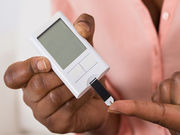Researchers suggest difference stems from both biological and care issues
WEDNESDAY, June 14, 2017 (HealthDay News) — Both biological and socioeconomic factors appear to play a role in higher hemoglobin A1c (HbA1c) readings seen in black patients with diabetes, according to research published online June 13 in the Annals of Internal Medicine.
The study included 104 black patients and 104 white patients with type 1 diabetes. The participants were all aged 8 or older and had diabetes for at least two years. Patients were recruited from 10 diabetes centers in the United States. The study volunteers wore a continuous glucose monitor for up to 12 weeks. This device measured blood glucose every 15 minutes. After 12 weeks, HbA1c levels were tested.
The mean HbA1c was 9.1 percent for black patients and 8.3 percent for whites — a difference of 0.8 percent. However, based on their daily blood glucose tests, the difference between the two groups should have only been 0.4 percent, the study authors said.
Lead author, Richard Bergenstal, M.D., executive director of the International Diabetes Center in Minneapolis, and colleagues found that both biological and socioeconomic factors appear to play a role in the difference. “It turned out to be a little bit of each. There’s a biological difference, and we don’t yet know why, but it accounts for about a half to a third of the blood glucose difference. The other part — which was an equal part or more — is from barriers to care,” Bergenstal told HealthDay. What’s important is that doctors and other health-care providers, as well as patients, don’t just assume these differences are normal and inconsequential, he noted.
Copyright © 2017 HealthDay. All rights reserved.








